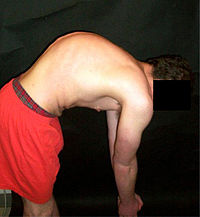
Photo from wikipedia
OBJECTIVE The primary goal of this study is to determine trends in patient 30-day postoperative readmission and reoperation following elective posterior lumbar fusion (PLF) between 2006-2016. METHODS We retrospectively identified… Click to show full abstract
OBJECTIVE The primary goal of this study is to determine trends in patient 30-day postoperative readmission and reoperation following elective posterior lumbar fusion (PLF) between 2006-2016. METHODS We retrospectively identified patients in the ACS-NSQIP database who underwent elective, non-emergent PLF from 2006 to 2016. Descriptive statistical and time trend analyses were performed on demographic, comorbidities, perioperative, and outcome variables. Primary outcomes were reoperation and readmission within 30 days and secondary outcomes were medical and surgical complications reported within 30 days of the operation. Linear and binary logistic regression were performed to adjust for patient specific confounders. RESULTS A total of 26,265 patients underwent elective PLF over the study period. Overall case volume increased from 0.02 % (n = 27) of all total cases in ACS-NSQIP in 2006 to 0.82 % (n = 8228) in 2016. Mean age increased from 51.22 [SE: 2.77] in 2006 to 60.57 [SE: 0.14] in 2016 (p < 0.001). For comorbidities, there was a decrease in smokers and increase in hypertension requiring medication and ASA Class 3. A readmission rate of around 5% per year did not vary significantly over the study period (p = 0.531). Unplanned reoperations declined from 7.4 % in 2006 to 3.1 % in 2016, but the overall trend from 2006 to 2016 was not statistically significant (p = 0.139). Reoperation demonstrated a significant association between age and BMI, but did not vary with admission year. Surgical site infections followed by hematomas and seromas were listed as the most common cause of both readmission and reoperation in PLF patients. CONCLUSION Since the establishment of the ACS-NSQIP database, reoperation rates due to complications declined after 2006 and remained relatively stable. Readmissions were added as a variable in 2011 and had no significant changes over time.
Journal Title: Clinical Neurology and Neurosurgery
Year Published: 2020
Link to full text (if available)
Share on Social Media: Sign Up to like & get
recommendations!